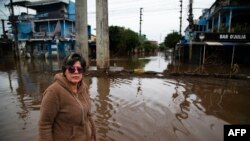Climate change and the El Niño weather phenomenon are to blame for the historic floods in southern Brazil that killed almost 170 people and displaced about 600,000 people, a team of international scientists said Monday.
The World Weather Attribution (WWA) group said climate change made the flooding twice as likely and that the heavy rains in April and May were amplified by the El Niño phenomenon.
WWA said in the published study that three months' worth of rain fell on the southern state of Rio Grande do Sul in two weeks. The “extremely rare” event, the group said, is something that was expected to happen only once every 100 to 250 years. The event would have been rarer still, if not for the effects of burning fossil fuel, the group said.
Entire towns and critical infrastructure were submerged in what local officials said was the worst disaster in the region’s history.
"The scary thing about these floods is that they show us that the world needs to be prepared for events so extreme, they are unlike anything we've seen before," said Maja Vahlberg, climate risk consultant at Red Cross Red Crescent Climate Centre.
The El Niño phenomenon, which raises temperatures around the world and increases the chances of heavy rains and flood risks, contributed to the catastrophe, according to the scientists.
El Niño is now in a weakened phase, but is still extremely dangerous, Regina Rodrigues, a Federal University of Santa Catarina said.
What is “very rare,” she said is the phenomenon that three of the four largest floods ever in Porto Alegre happened in the last three months, especially since Porto Alegre has not experienced a major flood in 60 years.
Other contributing factors that intensified the climate calamity, according to the report, included deforestation, the failure of critical infrastructure and rapid urbanization of cities, including Porto Alegre, Rio Grande do Soul’s capital.
Porto Alegre’s expansive flood protection system was built to withstand up to 6 meters of water but began failing at 4.5 meters because it had not been maintained properly.
The area’s residents had campaigned recently to remove the system altogether, complaining that it was an eyesore that blocked their view of the lake.
Despite warnings issued a week in advance about the upcoming flooding, Vahlberg said the warnings probably did not reach everybody and it was likely that not everyone understood “the severity of the expected impact.”
The flooding, according to the report, severely damaged 80 indigenous villages, at least 240 informal settlements and 40 communities where the residents are descendants of enslaved Africans.
Some information for this report came from Reuters and Agence France-Presse.











